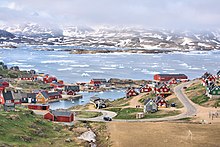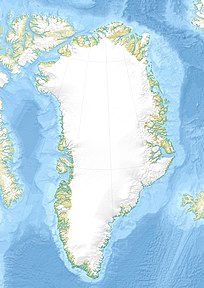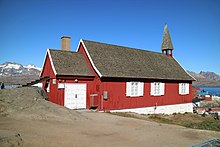Tasiilaq
| Tasiilaq (like an inland lake) | ||
|---|---|---|
| Ammassalik (place of capelin) Tasîlaĸ / Angmagssalik |
||
| Tasiilaq (2009) | ||
| Commune | Kommuneqarfik Sermersooq | |
| District | Ammassalik | |
| Geographical location | 65 ° 36 '42 " N , 37 ° 37' 56" W | |
|
|
||
| Residents | 1,985 (January 1, 2020) |
|
| founding | 1894 | |
| Time zone | UTC-3 | |
Tasiilaq [ taˈsiːɾɑ (q) ] (formerly Ammassalik [ ˌaˈmːasːalik ]; according to the old spelling Tasîlaĸ or Angmagssalik ) is a Greenland city in the Ammassalik district in the communeqarfik Sermersooq . With around 2000 inhabitants, Tasiilaq is the largest city in East Greenland .
location
Tasiilaq is located in the south of Ammassalik Ø on the west bank of the Kong Oscar Havn , a bay that is also called Tasiilaq in Greenlandic . The place name is the East Greenlandic form of Tasiusaq , which translates as an inland lake and, as with the West Greenlandic towns of Tasiusaq (Nanortalik) and Tasiusaq (Upernavik), refers to the location on a sheltered bay with a narrow inlet. The closest inhabited place is Kulusuk 21 km east on the other side of Ammassaliip Kangertiva .
history
Before the colonial era
The region was settled by members of the Alaskan Saqqaq culture about 4,500 years ago , and by members of the Dorset culture about 2,600 years ago . These settlers were unable to survive in the worsening climatic conditions on the east coast. Inuit of the Thule culture migrated to the area from around the 14th century .
A few hundred years ago the east coast was still continuously populated and Wilhelm August Graah regularly encountered Tunumiit on his expedition in 1830 , even if he only got within 100 km of today's settlements. In the following decades, however, most of the Inuit in Southeast Greenland migrated to South Greenland and there was a gap of about 600 km between the Kujataamiut in South Greenland and the Tunumiit in what is now the region around Tasiilaq.
Despite the great distance, however, Tunumiit occasionally came to South Greenland to trade there. In search of the origin of these, the Danish naval officer Gustav Frederik Holm led the women's boat expedition in 1884 , the first expedition to the area around Tasiilaq. He found 413 tunumiit here, the number falling steadily due to famine and disease. Holm spent the winter in Tasiilaq, as the place was originally called, and studied the residents.
Carl Ryder counted only 294 people in 1892 and the population was threatened with extinction and the remaining Tunumiit wanted a higher standard of living, comparable to that of the Kitaamiut in western Greenland.
Foundation of the station
In 1894, the first mission and trading post in East Greenland was finally built, which was named Ammassalik . Johan Petersen was appointed trade administrator and Frederik Carl Peter Rüttel became East Greenland's first missionary. A house was built for the missionary and a cemetery next to it. There was also a house for the trade manager. All the rest of the employees lived in another building. In addition, a food store was set up for supplies. All buildings were half-timbered houses with paneling.
In the following years the mission station was greatly expanded. In 1899 a store and warehouse was built. In 1900 a house was built for the catechist, in 1901 and 1903 two houses for Kiffat (Greenlandic helpers). In 1901 a coal house was built. Construction of the church began in 1903 and was not completed until 1908. There was also a classroom in it. In 1904 the trade administrator's apartment was expanded.
Earthquakes are more common in Tasiilaq . In the winter of 1904/05 the earthquakes were so strong that the population came to the Europeans and asked whether the world was going to end .
In 1911 a house was built for the sales assistant and in 1912 a separate apartment for the midwife. The old house, which originally served as a residential building for all employees, ultimately only served as a hospital and apartment for the midwife, and when the midwife got her own house, the building was converted into a guest apartment. A wash house was built in 1913 and a powder house in 1915. In 1918 a second coal house was built and the old one was rebuilt. A building originally built by Georg Carl Amdrup for scientific purposes was used as a workshop and material shed from 1919. In the same year a packing house was built.
In 1920 there were nine family members of the Danish missionary and 74 Greenlanders living in Tasiilaq. Of the residents, 37 lived in the station itself and 37 on the peninsula called Grønlænderpynten east of the station, although by 1915 there were as many as 50 to 60. There were five Greenlandic houses in the station, and two or three on the peninsula. Usually employed Greenlanders lived in the station, who helped with missionary and trade work, while the peninsula was home to the baptismal candidates who moved away after two years of instruction. There were 14 hunters among the residents. The pastor, a catechist, the trade administrator, a helper, a midwife and three kiffats worked in the ward.
Tasiilaq developed into the central settlement of the district. Despite illnesses and alcohol problems brought in by the Europeans, the population increased sharply due to the improved food situation. Immediately with the establishment of the settlement, the monetary economy and the import of technical products for everyday life began. For example, by the turn of the century, the 400 residents of the colonial district had acquired 87 hunting rifles. The peat wall houses were replaced by wooden ones by around 1980.
Tasiilaq as a colony
In 1925 Tasiilaq received colony status. In the same year, 84 Ammassalimmiut were relocated to Ittoqqortoormiit , newly founded by Ejnar Mikkelsen , under the leadership of Johan Petersen . It was not until 1963 that East Greenland, like the Thule region, was decolonized and incorporated into the rest of Greenland for administrative purposes.
After the colonial era
On February 5, 1970, the strongest ever recorded Piteraq , an East Greenland storm phenomenon, destroyed large parts of the city with wind speeds of around 300 km / h, so that one even considered abandoning it.
In 1977, 1992 or 1997 the place name was officially renamed back to Tasiilaq , while the name of the former municipality remained with the previous name. The municipality was incorporated into the Kommuneqarfik Sermersooq during the administrative reform in 2009 .
Infrastructure and supply
The port of Tasiilaq can be approached from July to November. It consists of a large quay and several jetties for small boats. The Tasiilaq heliport connects the city with East Greenland's airport in Kulusuk .
Nukissiorfiit has been supplying the city with a hydroelectric power station since 2004. The garbage is dumped and wastewater discharged into the sea. Half of the buildings in Tasiilaq are connected to the sewage network.
Development
The Tasiilami Alivarpi teaches about 450 students. It was first built in 1957, but destroyed by the Piteraq in 1970. The new building from 1971 was supplemented by a gymnastics room in 1978 and a workshop in 1984 and finally expanded and renovated in 2001. There is a branch of both Piareersarfik and Piorsaavik in Tasiilaq, which are supposed to prepare young people for working life.
The city also has a children's home, two kindergartens, a day nursery and a home for the elderly. Tasiilaq has a hospital, a police station, a meeting house, a municipal office, a sports hall, the new church from 1985 and the old church from 1908 which is now the Ammassalik Museum. There is also a Pilersuisoq branch and another shop, a few kiosks, a bakery, an internet café, a bookstore, a post office, a construction company, a craft company, a tourism office and a hotel. Tasiilaq is also the headquarters of POST Greenland , from where Greenlandic postage stamps are sent to philatelists .
Town twinning
Sports
The city is home to the Ammassalimmi Timersoqatigiiffik Ammassak football club.
sons and daughters of the town
- Kârale Andreassen (1890–1934), painter and teacher
- Isak Lund (1902–1949), National Councilor
- Kâle Rosing (1911–1974), artist
- Justus Hansen (* 1968), politician (Demokraatit)
- Mala Høy Kúko (* 1969), politician (Siumut)
- Naaja H. Nathanielsen (* 1975), politician (Inuit Ataqatigiit) and psychologist
- Emanuel Nûko (* 1992), politician (Partii Naleraq)
Population development
The population of Tasiilaq has doubled in the past 40 years. After Nuuk, Tasiilaq is the city with the second highest relative growth since 1977. Today Tasiilaq is the largest city in East Greenland and the seventh largest in the country. Almost a third of the population of East Greenland lives in Tasiilaq.

Web links
Individual evidence
- ↑ Map with all official place names confirmed by Oqaasileriffik , provided by Asiaq
- ↑ a b Ammassalik at groenlandkreuzfahrt.de
- ↑ a b c d history at ammassalik.museum.gl
- ↑ Kurt L. Frederiksen: Ejnar Mikkelsen . Gyldendal, 2015, ISBN 978-87-02-17408-3 , pp. 35 ( limited preview in Google Book search).
- ^ Sabine Barth: Greenland. DuMont Travel Paperback. Ostfildern, 2010. p. 254.
- ^ A b c d e Gustav Frederik Holm , Johan Petersen : Beskrivelse af Angmagssalik district. Trading and mission stations Angmagssalik ved Tasiussaĸ. In: Georg Carl Amdrup , Louis Bobé , Adolf Severin Jensen , Hans Peder Steensby (eds.): Grønland i tohundredeaaret for Hans Egedes landing (= Meddelelser om Grønland . Volume 60-61 ). tape 2 . C. A. Reitzel Boghandel, Copenhagen 1921, p. 638 ff . ( Digitized in the Internet Archive ).
- ↑ Grete K. Hovelsrud-Broda: The Integrative Role of Seals in on East Greenlandic Hunting Village. In: Arctic Anthropology, Vol. 36, No. 1/2, University of Wisconsin Press, 1999, pp. 37-50, here p. 37
- ↑ Jens Christian Madsen: Udsteder og bopladser i Grønland 1901-2000 . Atuagkat, 2009, ISBN 978-87-90133-76-4 , pp. 208 .
- ↑ a b Ammassalik Kommune in Den Store Danske
- ↑ The riddle of the ice falls from Greenland . Mirror online
- ^ Nyt navn in the Atuagagdliutit of December 8, 1977
- ↑ a b Angmagssalik in Den Store Danske
- ↑ Tasiilaq in Den Store Danske
- ↑ a b c Tasiilaq (PDF) at sermersooq2028.gl
- ↑ Kópavogur Vinabæir . nat.is
- ↑ Population of Tasiilaq 1977–2020 at bank.stat.gl








